15,000 38,000 | Date 28 June 1575 | |
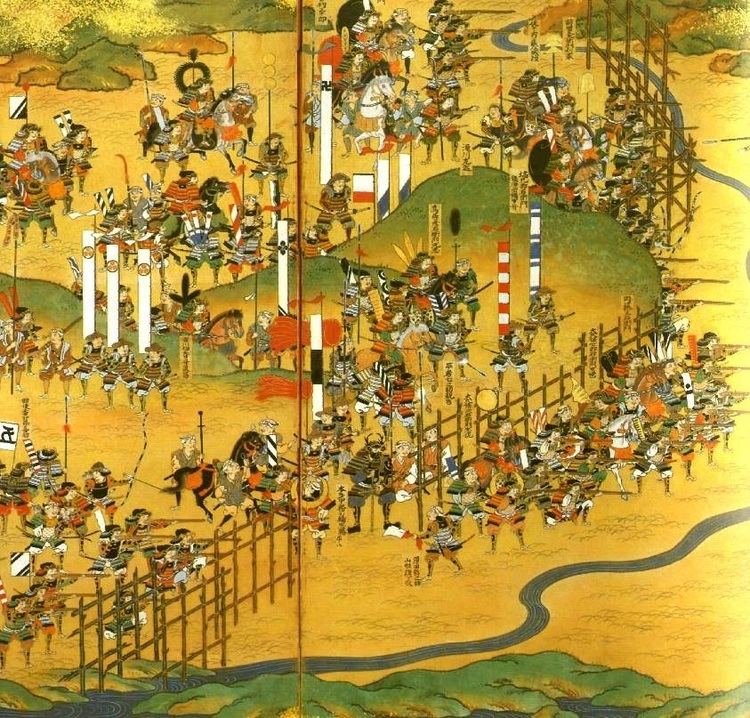 | ||
Similar Battle of Okehazama, Battle of Mikatagahara, Battle of Anegawa, Battle of Sekigahara, Honnō‑ji incident | ||
Battle of nagashino 1575
The Battle of Nagashino (長篠の戦い, Nagashino no Tatakai) took place in 1575 near Nagashino Castle on the plain of Shitarabara in the Mikawa Province of Japan. Takeda Katsuyori attacked the castle when Okudaira Sadamasa rejoined the Tokugawa, and when his original plot with Oga Yashiro for taking Okazaki Castle, the capital of Mikawa, was discovered.
Contents
- Battle of nagashino 1575
- Nobunaga s ambition sphere of influence battle of nagashino takeda side
- Battle
- Film
- Video games
- Additional reading
- References
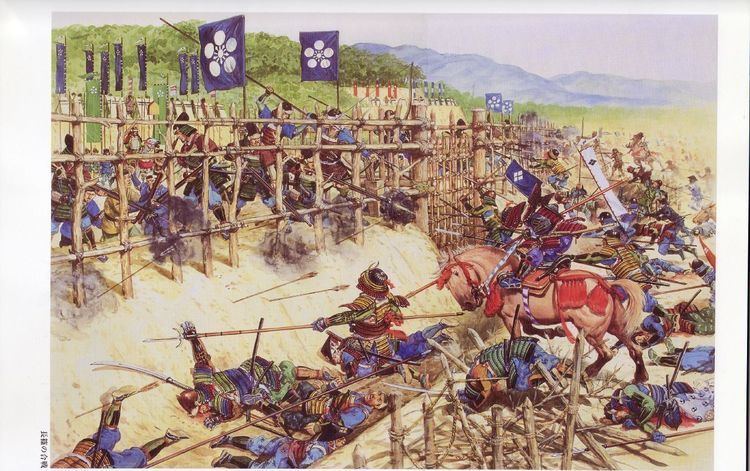
Takeda Katsuyori attacked the castle on 16 June, using Takeda gold miners to tunnel under the walls, rafts to ferry samurais across the rivers, and siege towers. On 22 June the siege became a blockade complete with palisades and cables strewn across the river. The defenders then set Torii Suneemon to get help. He reached Okazaki, where Ieyasu and Nobunaga promised help. Conveying that message back to the castle, Torri was captured, and hung on a cross before the castle walls. However, Torri was still able to shout out relief was on the way before he was killed.
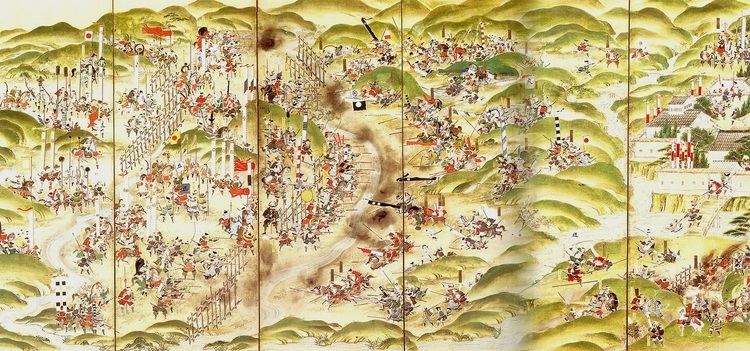
Both Tokugawa Ieyasu and Oda Nobunaga sent troops to assist Sadamasa and break the siege, and their combined forces defeated Katsuyori. Nobunaga's skillful use of firearms to defeat Takeda's cavalry tactics is often cited as a turning point in Japanese warfare; many cite it as the first "modern" Japanese battle. In fact, the cavalry charge had been introduced only a generation earlier by Katsuyori's father, Takeda Shingen. Furthermore, firearms had already been used in other battles. Nobunaga's innovation was the wooden stockades and rotating volleys of fire which led to a decisive victory at Nagashino.
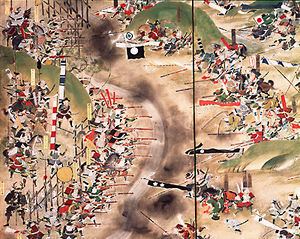
Nobunaga s ambition sphere of influence battle of nagashino takeda side
Battle
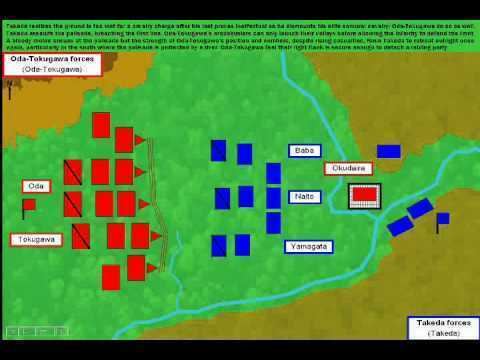
According to the Shinchō kōki, Nobunaga and Ieyasu brought a total force of 38,000 men to relieve the siege on the castle by Katsuyori. Of Takeda's original 15,000 besiegers, only 12,000 faced the Oda-Tokugawa army in this battle. The remaining 3000 continued the siege to prevent the garrison in the castle from sallying forth and joining the battle. Oda and Tokugawa positioned their men across the plain from the castle, behind the Rengogawa, a small stream whose steep banks would slow down the cavalry charges for which the Takeda clan was known.
Seeking to protect his arquebusiers, which he would later become famous for, Nobunaga built a number of wooden palisades in a zig-zag pattern, setting up his gunners to attack the Takeda cavalry in volleys. The stockades served to blunt the force of charging cavalry.
Of Oda's forces, an estimated 10,000 Ashigaru arquebusiers, 3,000 of the best shots were placed in three ranks under the command of Sasa Narimasa, Maeda Toshiie, and Honda Tadakatsu. Okubo Tadayo was stationed outside the palisade, as was Sakuma Nobumori, who feigned a retreat. Shibata Katsuie and Toyotomi Hideyoshi protected the left flank. Takeda Katsuyori arranged his forces in five groups of 3,000, with Baba Nobuharu on his right, Naito Kiyonaga in the center, Yamagata Masakage on the left, Katsuyori in reserve, and the final group continuing the siege.
A night attack on the eve of the battle by Sakai Tadatsugu killed Takeda Nobuzane, a younger brother of Shingen.
The Takeda army emerged from the forest and found themselves 200–400 meters from the Oda-Tokugawa stockades. The short distance, the great power of the Takeda cavalry charge and the heavy rain, which Katsuyori assumed would render the matchlock guns useless, encouraged Takeda to order the charge. Takeda's cavalry was feared by both the Oda and Tokugawa forces, who had suffered a defeat at the Mikatagahara.
The horses slowed to cross the stream and were fired upon as they crested the streambed within 50 meters of the enemy. This was considered the optimum distance to penetrate the armor of the cavalry. In typical military strategy, the success of a cavalry charge depends on the infantry breaking ranks so that the cavalry can mow them down. If the infantry does not break, however, cavalry charges will often fail—with even trained warhorses refusing to advance into the solid ranks of opponents.
Between the continuous fire of the arquebusiers' volleys and the rigid control of the horo-shu, the Oda forces stood their ground and were able to repel every charge. Ashigaru spearmen stabbed through or over the stockades at horses that made it past the initial volleys and samurai, with swords and shorter spears, engaged in single combat with Takeda warriors. Strong defenses on the ends of the lines prevented Takeda forces from flanking the stockades. By mid-day the Takeda broke and fled, and the Oda forces vigorously pursued the routed army.
According to Shinchō kōki, Takeda suffered a loss of 10,000 men, two-thirds of his original besieging force.
Several of the Twenty-Four Generals of Takeda Shingen were killed in this battle, including Baba Nobuharu, Hara Masatane, Sanada Nobutsuna with his younger brother Sanada Masateru, Yamagata Masakage, Saigusa Moritomo, Tsuchiya Masatsugu, and Naitō Masatoyo. Obata Masamori received a mortal wound.
Film
The Battle of Nagashino and the last years of the Takeda clan are dramatized in Akira Kurosawa's 1980 film Kagemusha (Shadow Warrior). In the film, a wayward thief is recruited to impersonate the dead Takeda Shingen in the years preceding Takeda Katsuyori's defeat at Nagashino. At the end of the film, the thief witnesses the battle and at its end he dies trying to raise the Takeda flag.
Video games
The Battle of Nagashino is a significant part of many PlayStation 2 games, predominantly Koei's Kessen III and Samurai Warriors. If Shingen is the playable character in Samurai Warriors, there is a 'what-if' situation which examines what would have happened if he had not died: Shingen successfully reads the feint, and does not charge. It then starts raining, rendering the arquebuses worthless except as clubs. Only then would the Takeda cavalry charge, completely routing the Oda-Tokugawa combined forces. Likewise, this can be done in Uesugi Kenshin's Story in Samurai Warriors 2 where due to a historical tangent, Kenshin joins the living Shingen at Nagashino (although perhaps ironically or humorously, in at least one version of SW2's raining at Nagashino, Nobunaga responds by ordering his arquebusiers, "Simply use your rifles to beat them to death"). In Samurai Warriors 3 if playing any character besides Shingen, he will appear, not dead, when you get close to getting to the goal of defeating Katsuyori. This changes the end goal from defeating Katsuyori to defeat Shingen.
The battle is recreated in the strategy game Shogun 2: Total War, with the player taking control of Oda Nobunaga's troops. If players recreate Nobunaga's strategy utilizing Ashigaru spearmen and arquebusiers, they can defeat the powerful Takeda cavalry charge.
